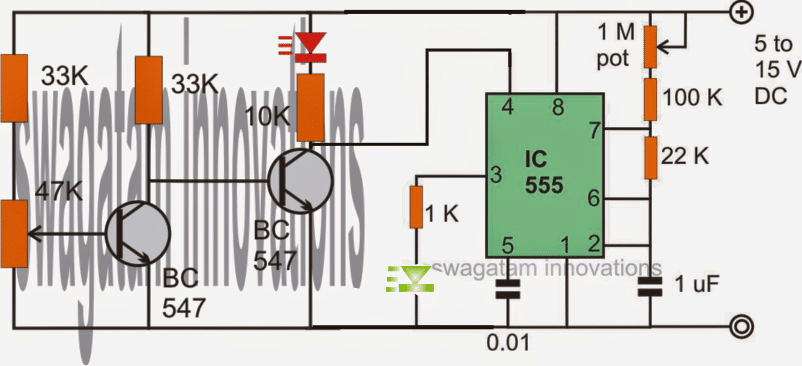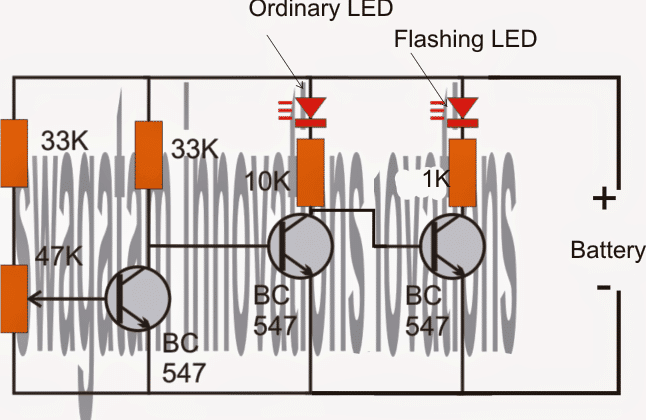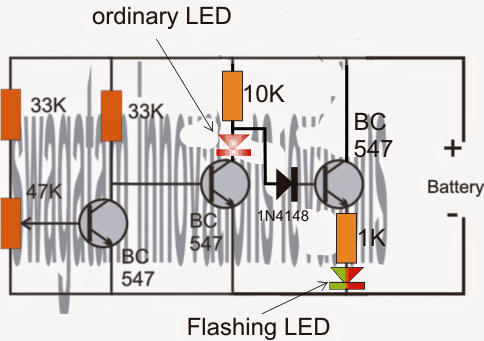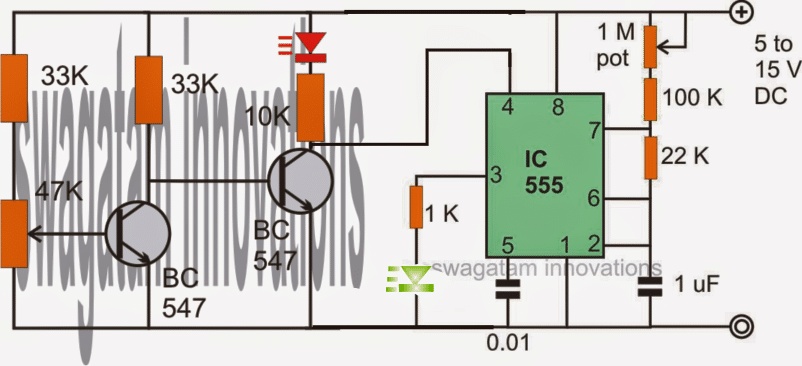In this post I have explained a simple low/normal battery voltage status indicator circuit through a flashing and a constant LED, where the flashing LED indicates a normal status while the solid indicator warns against a low battery condition. The idea was requested by Mr.Alf.
Technical Specifications
Hi, I found and built your “Low Battery Indicator Circuit Using Two Transistors Only”
On your website because I am growing vegetables in a raised bed and have erected 12v electric fence to prevent slugs and snails eating my plants.
for this I am using an old car battery which is holding a good charge.
The low battery indicator circuit is working fine but I have to put my meter across the terminals in order to check it is still working.
Is there any way to add a second LED that will flash to indicate power is there and working?
Thanks
Alf
The Design
The figure below shows the circuit configuration of the proposed battery voltage status indicator circuit through a flashing LED indicator.
The left side stage which uses two BJTs is a simple low battery indicator circuit, the red LED lights up as soon as the supply voltage falls below the predetermined threshold level, as set up by the 47K preset.
This stage has been elaborately explained HERE, you may want to go through it for further details.
Low Battery Indicator with Astable LED
The low battery stage produces only a low voltage indication and the relevant LED shines only until the level dips below the set threshold, this might well keep the user guessing if the actual or the normal condition of the battery was OK and if the battery was functioning correctly in the meantime.
For satisfying the above results, a flashing LED indicator could be seen attached with the low battery section, using our old compatriot IC 555.
The IC 555 is wired in its conventional astable mode so that the connected green LED produces a flashing effect as long as its reset pin#4 stays above a certain positive voltage level via the red LED and the series 10k resistor.
Until the set lower threshold is not reached, the above pin of the IC is allowed to receive the specified amount of positive potential sustaining the green LED in a blinking mode, which in turn indicates that everything is well with the battery.
The moment the red LED starts glowing and gets illuminated sharply the green LED completely shuts down, making the conditions clear to the user regarding the battery which may be assumed to be fully down and gone below the dangerous low voltage mark.
The flashing rate of the 555 stage could be adjusted as per user preference by adjusting the 1M pot appropriately.

Solving the Low Supply Issue
For lower voltage applications, the IC 555 stage may not function correctly since its minimum operating voltage is 4.5V, under such conditions the following configuration could be tried.
Here we find a third BJT being added to the existing stage, which holds a multicolor RGB flashing LED for the required indications (the same may be replaced with a simple LED if the flashing effect is not required).
The results obtained are identical, the left LED illuminates when a low voltage is detected, until this happens the flasher LED keeps blinking indicating a normal operation of the battery.

Improving the Circuit Outcome
The above circuit has an issue and may not work as intended, because the left LED would be always ON due to the conduction via the right hand side BC547 emitter.
The following circuit corrects the above issue and may be used for implementing the proposed flashing LED battery status indication flawlessly.

Upgrading the Circuit with an Opamp
If a single LED is intended to be used for indicating the above effects, the following design may be tried. The idea is designed and explained by Mr. Abu-Hafss.

The circuit presented here features a single LED which:
Circuit Operation
a) when light up constantly would indicate the power has been switched ON and the battery charge level is good.
b) when flashes would indicate battery is low
The design is pretty straight forward, consisting of two parts. In the green part, op-amp 741 configured as comparator, along with its corresponding components compares the voltage with the reference voltage preset using a zener diode. If the voltage is higher than the threshold level, the output of 741 remains low which causes the PNP Q1 to conduct hence, the LED is powered on constantly.
As soon as the voltage level falls below the threshold level the output of 741 goes high. This causes the Q1 to stop conducting and the LED goes off. At the same time, the high output of 741 also switches on the flasher circuit in blue part (built around a pair of an NPN and a PNP transistor) which causes the same LED to flash. The flashing rate can be adjusted by varying the values of R8 and/or C1.
Alternatively, to make the flashing circuit more compact, this circuit may be tried.
